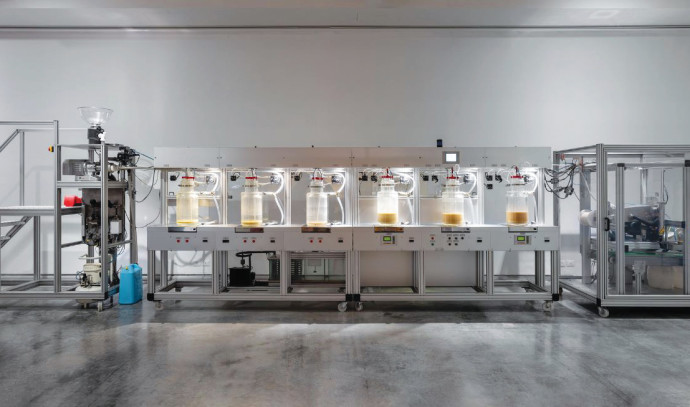Food and seduction. Two words that may not always go together, however, are more related than they seem. Eating is supposed to bring us pleasure and make our stomachs full but what if we changed the way we thought about food? What if it made us uncomfortable?
It isn’t often that someone really thinks about the food they are indulging in. Marketing campaigns form relationships with buyers and convince us not to question the products and, as consumers, we unknowingly abide by this “don’t ask, don’t tell” strategy. But, what if we asked?
With these questions in mind, the Design Museum Holon created Food, a new exhibition combining interactive exhibits, video displays, familiar products and various skeptical designs. According to its curators, the exhibition works to challenge the way we think about food and the role it plays within society.
In 2016, the museum had an exhibition on vision and glasses and in 2017, they focused on hearing with their Sound exhibition. Following the theme of senses, Maya Dvash, chief curator of Design Museum Holon, says that the idea of a food-based exhibition had always been intriguing to her.
“It seemed only logical that our next exhibition about the senses would be concerned with food,” Dvash said. “The exploration of food and the processes of its design and consumption reveal a range of design-related considerations, emphases and choices while raising questions about the impact of food on culture, identity and the emotions that shape our experience.”
There are three main exhibitions that contribute to the overall message of food in society and its relationship with humans. The main exhibition is Food. Created by Liora Rosin and Dana Benshalom, it focuses on the relationship between humans, food, seduction and intimacy.
“The exhibition Food explores the basic yet tangled relations between humans and their food and the complex role of design practices in this equation,” Rosin and Benshalom said. “It seeks to explore the various strategies of seduction activated both in the natural world and in the human world while delineating the sequence of transfers on the food chain.”
“The exploration of food and the processes of its design and consumption reveal a range of design-related considerations, emphases and choices while raising questions about the impact of food on culture, identity and the emotions that shape our experience.”
Maya Dvash
The over 200 creations by different artists both in Israel and abroad, “are sure to awaken and excite both the stomach and mind,” Rosin and Benshalom said.
Rosin and Benshalom share that taste is actually the last of our senses to engage in the practice of eating. Hearing, smell, sight and touch are actually what drive our reactions to various foods and trigger desire or disgust.
“The sound of a sunny-side-up egg being fried in a pan, the smell of fresh bread, grill marks on a seared chunk of meat, or the feeling of holding a ripe avocado in one’s hand – these are just a few of the ways in which we are seduced by food,” Rosin and Benshalom said.
The exhibition’s three main themes
THE EXHIBITION follows three main themes: Needs and Desires, Attraction and Repulsion, and Restraint, Preservation and Liberation.
Although some of these exhibits may seem normal or appetizing, they are designed to make us think about the bigger picture of why and how.
Moving jello, ASMR eating videos and a knitted steak cause us to think about why these interpretations of popular dishes make us question or cringe.
Following Food, visitors can see Colored, created by Lior Hermoni-Gati, director of Aharon Feiner Eden Materials Library. Colored focuses on food coloring and how the different colors of our food may influence our feelings and appetites.
“You eat with your eyes” may seem overdone, however, it still remains true in the way we conceptualize what we are eating and what we choose to eat. Food coloring is often added to invoke the visual attraction to foods that otherwise may not be as appealing.
Various discolored foods cause us to think about the synthetic food we are eating and how we associate different colors when it comes to our appetite.
“Red is identified with flavors and qualities such as sweetness and ripeness, green is identified with acidity and freshness, yet how dominant is color in creating an expectation for a certain flavor?” Hermoni-Gati said. “What is the flavor of a blue drink? What is the right color for an egg yolk? And what does black represent in the context of food in addition to rot, mildew and poison?”
Different foods are showcased in this exhibit, however, there are aspects that may be disturbing to some. Discolored strawberries, clear Pepsi, blue chicken and the most jarring, what is really used to color red items, such as licorice, candy canes and Campari.
Lastly, A Taste of The Future, curated by Talia Janover, uses AI technology to explore the future of our food. This exhibit highlights scent and memory within our food and normalizes the beauty of imperfection.
The exhibit gives participants the opportunity to be interactive while smelling different familiar scents and seeing changing plates – some with bugs – posing the question of what our food will look like years from now. A Taste of The Future draws on all senses, working together to envision and question what the evolution of food will look like.
It shows the relationships humans have had with the environment over time and how that has changed and will continue to evolve over time. It leads us to questions, such as the role insects and animals play in relation to humans, how we will gather food in the future and how we can change the way we eat with the addition of senses other than taste.
“Although the future has yet to arrive, scientists, researchers and designers are already connecting past and future, extending the limits of the human imagination and revealing the potential embodied in possible futures,” Yanover said.
For more information regarding ticket sales and exhibition dates, visit: www.dmh.org.il/en/exhibitions/food.



